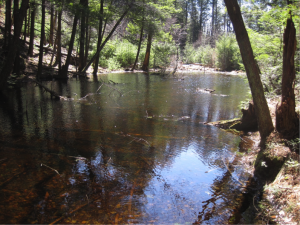During mid-February, a warm breeze rushes by instead of an expected snow flurry. It should be no surprise that human activities – such as the burning of fossil fuels and deforestation – are partially to blame for increasingly warm temperatures. Yet, less well-known are the natural sources of atmospheric carbon present since before human activities led to climate change. Could ponds be a natural contributor to greenhouse gas emissions?

Researchers at Yale University recently found that very small ponds emit a disproportionate amount of the greenhouse gases carbon dioxide (CO2) and methane (CH4) relative to their surface area. Yet, since small ponds are hard to view by satellite, they have traditionally been left out of carbon flux, or movement, calculations. This new study demonstrates the importance of accounting for these small bodies of inland water in the global carbon budget.
The global carbon cycle describes the movement of carbon through the Earth’s atmosphere, oceans, land, and rock. Carbon “sinks,” which include terrestrial plants and oceans, remove and store carbon from the atmosphere. They play an important role as atmospheric carbon, primarily existing as CO2 and CH4, can be problematic for the environment. Both gases – especially CH4, a gas 20 times potent than CO2 – are key greenhouse gases, and heat up the Earth’s atmosphere.
Oceans are good at reducing atmospheric carbon, but not all bodies of water are. Ponds and lakes, for instance, are known to do the opposite. Because small bodies of inland water are often situated under canopies of vegetation in concave positions on the landscape, they collect falling leaf litter and other sources of terrestrial carbon that is decomposed by microbes into CO2.
Despite its importance, the carbon flux from small ponds has been overlooked in past estimates of greenhouse gas budgets because the global distribution of very small ponds is hard to map. Very small ponds are difficult to see by satellite imaging. Furthermore, two other variables for carbon flux calculations, carbon concentrations and gas transfer velocity, are difficult to estimate accurately for small ponds.
In the study, researchers Meredith Holgerson and Peter Raymond compiled direct measurements of CO2 and CH4 concentrations from 427 lakes and ponds around the world. After clustering these lakes and ponds into seven categories by size, Holgerson found that CO2 and CH4 concentrations were disproportionately high in the smallest ponds.
This observation may be explained by the high perimeter to surface area ratio and shallow depth of small ponds. These allow small ponds to receive more terrestrial carbon and release more CO2. Furthermore, because small ponds are often shallow, mixing between layers of the pond is more rapid. Thus, CH4, produced in the oxygen-deficient sediments at the bottom of ponds, escapes into the atmosphere before it can be converted into other compounds.
Surprisingly, though very small ponds only make up 8.6% of lakes and ponds by area globally, Holgerson discovered that they are responsible for 15.1% of inland water CO2 emissions and 40.6% of inland water CH4 emissions. “While…each pond is small, they collectively made a large contribution to the global carbon cycle in inland waters,” said Meredith Holgerson, a Yale doctoral student.
The impact of very small ponds shows the necessity to include them in future estimates of carbon flux from inland waters. As expected, there are a few hurdles along the way. “We need more direct measurements of carbon dioxide from inland waters. Current methods using extrapolation are pretty accurate for many, but not all, water bodies,” Holgerson said. Mapping the global distribution of these small ponds will also pose a challenge. By replacing traditional satellite methods by light detection and ranging data (LiDAR) – which works by airborne laser scanning – researchers may be able to provide better estimates.
“This sort of effort to get global inland water [greenhouse gas] emissions is fairly new. These tiny systems have not been part of any other efforts,” said Peter Raymond, Yale professor of ecosystem ecology.
